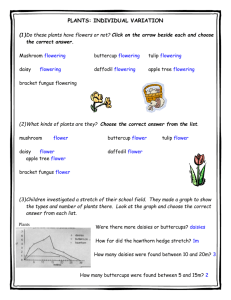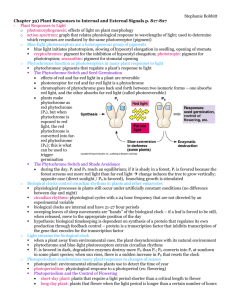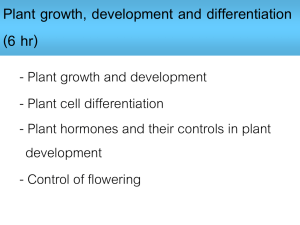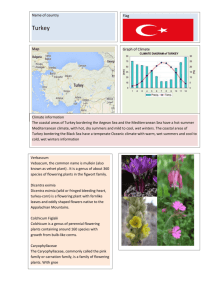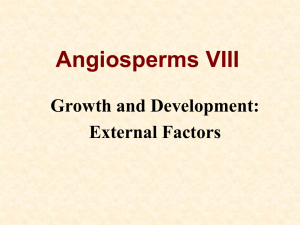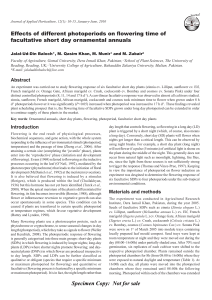photoperiod
advertisement
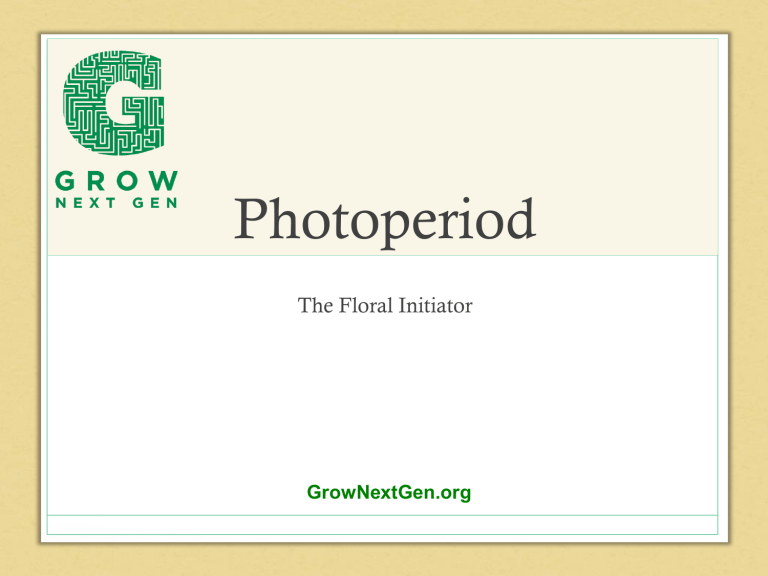
Photoperiod The Floral Initiator GrowNextGen.org Photoperiodism • the ability of an organism to detect day length • allows plants to “know” what season of the year it is • allows for certain physiological events to occur during a certain season of the year Why are there photoperiods? • Earth’s axis remains tilted in the same direction throughout a year. This means that one hemisphere, will be directed away from the Sun at one side of the orbit, and a half year later, this pole will be directed towards the Sun. • Latitude has a great effect on day length at different times of the year (see Figure 1). At the equator, day length and night length are equal and constant throughout the year; as one moves away from the equator towards the poles the days become longer in summer and shorter in winter • Plants have evolved specific photoperiod responses that are strongly influenced by the latitude in which they originate 20 18 Effect of latitude on photoperiod at different times of the year 17 Northern Hemisphere 16 Data recorded on the 21st of each month in 2014 19 15 Day Length in Hours Quito, Ecuador 0.23 Mexico City, Mexico 19.43 14 Columbus, Ohio 39.98 Seattle, Washington 47.37 13 Anchorage, Alaska 61.21 Полиномиальная (Quito, Ecuador 0.23) 12 Полиномиальная (Mexico City, Mexico 19.43) 11 Полиномиальная (Columbus, Ohio 39.98) Полиномиальная (Seattle, Washington 47.37) 10 Полиномиальная (Anchorage, Alaska 61.21) 9 8 Spring Summer Solstice 7 Fall Equinox http://www.timeanddate.com/sun/ 6 5 http://www.theflatearthsociety.org J F M A M J J A Month of the Year S O Anchorage Seattle Columbus Mexico City Quito http://www.theflatearthsociety.org http://www.theflatearthsociety.org What are plant responses to photoperiod? • In plants, photoperiod responses include: • the initiation of flowering (flowering in beans), • asexual reproduction (runner formation in strawberry), • the formation of storage organs (tuber formation in potatoes) and • the onset of dormancy (trees lose their leaves in fall) Flowering categories • Flowering plants tend to fall into one of five categories: • Short-day Plants: flower only when the day length is less than a certain critical duration in a 24-hour cycle • Long-day Plants: flower only when the day length exceeds a certain critical duration in a 24-hour cycle • Long-short-day Plants: flower only when a period of long days is followed by a period of short days • Short-Long-day Plants: flower only when a period of short days is followed by a period of long days • Day-neutral Plants: flower under any photoperiodic condition Difference between SDP’s and LDP’s Flowering in LDPs occurs after day length exceeds a specific duration; this duration/value is referred to as critical day length (CDL). • For example, soybeans have a natural CDL of 14 hours Flowering is determined chiefly by the duration of darkness and not by the light periods • Even under long light conditions, SDPs were able to flower if the days were followed by sufficiently long periods of dark • Also under short light conditions, LDPs were able to flower if the short light periods were followed by short periods of darkness • Another factor that signifies the importance of dark periods is called a night break, an interruption of a dark period by a flash on small duration of light. • • Night breaks treatments of only a few minutes are effective enough in preventing flowering in many SDPs While longer night break treatments are required to induce flowering in LDPs • While the initial example of soy having a CDL of 14 hours is correct, the technical answer would be that soy flowers only when nights exceed 10 hours of darkness • Because of these experiments with night breaks, many greenhouses use lights at night to cause flowering in many species such as chrysanthemum and poinsettia How do plants know what the length of the day is? Plants detect light using specialized proteins called photoreceptors • When bombarded by light changes the photoreceptive protein, causing a cascade of physiological responses • Phytochrome is the primary photoreceptor in photoperiodism. • Bombardment by red light changes the structure and confirmation of phytochrome, causing it to take on a biologically active shape (see Figure 2). • Inactive phytochrome is produced and found freely in the cytoplasm of the plant cell, but once it is activated, phytochrome is translocated and allowed to enter the cell’s nucleus, where it then acts with transcription factors to express genes that are photoperiod controlled Soybeans and photoperiod While soy is a short-day plant, photoperiod sensitivity is not uniform among cultivars, or groups • Soybean cultivars are classified according to their response to photoperiod into one of eight maturity classes commonly used in the USA (0-VIII) • In Ohio, the earliest maturing cultivars that are adapted to the north of the state are designated II, and later maturing cultivars that are adapted to more southern locations are designated either III or IV. • Maturity class increases when moving further south, with O being used in Minnesota and North Dakota to VIII in the Southern US. • These classifications allow farmers to choose a cultivar that flowers and matures at a certain time of the year, giving them a tailored crop for their location and farm. • Farmers can use multiple classification of beans to spread out their harvest or keep it standardized over the whole system Far-Red Light Red Light Inactive Activated Light Regime Light Dark Flowering Response SDP LDP Flowering Vegetative Vegetative Flowering Vegetative Flowering Vegetative Flowering Vegetative Flowering Flowering Vegetative
